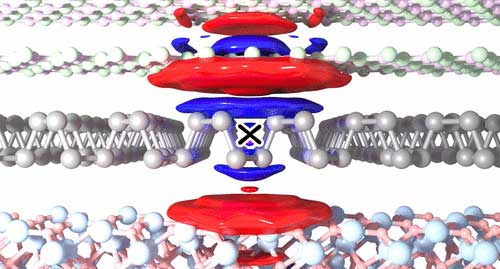| Posted: Jul 05, 2017 |
The comeback kid - black phosphorus and its new potential
(Nanowerk News) When it was discovered over a century ago, black phosphorus was considered relatively useless. Over the past five years, however, the engineers and chemists have become intrigued by the material for its potential as an ultra-thin semiconductor, possibly ushering in a new age of flexible and smaller electronics.
|
|
Now, one group reports in Nano Letters ("Environmental Screening Effects in 2D Materials: Renormalization of the Bandgap, Electronic Structure, and Optical Spectra of Few-Layer Black Phosphorus") that some commonly held assumptions about black phosphorus are incorrect and that the material is exceptionally tunable.
|
 |
| Black phosphorus is exceptionally sensitive to environmental screening. Encapsulation reduces the exciton binding energy in 1L by as much as 70% and completely eliminates the presence of a bound exciton in the 4L structure. The reduction in the exciton binding energies is offset by a similarly large renormalization of the QP bandgap so that the optical gap remains nearly unchanged, but the nature of the excited states and the qualitative features of the absorption spectrum change dramatically. (© ACS)
|
|
Black phosphorus is emerging as a promising 2D semiconductor material. Semiconductors have a narrow band gap that allows them to conduct electricity. Black phosphorus can absorb and emit light in the visible through infrared spectrum, which is useful for sensors, communications and other applications. But when black phosphorus is put into devices, it breaks down rapidly in ambient conditions.
|
|
To combat this degradation, researchers have encapsulated black phosphorus with passive insulators, assuming that this containment did not affect its properties; however, Steven Louie, Diana Qiu and Felipe da Jornada wanted to determine whether this was theoretically true.
|
|
The researchers performed calculations on one- to four-layer versions of black phosphorus, both with and without encapsulation, to examine its properties in a more systematic way. Some black phosphorus characteristics, such as the onset of optical absorption, were nearly unaffected in the calculations. But others, such as the band gap and shape of the optical absorption changed dramatically, so the properties of the material become qualitatively different.
|
|
These findings indicate that the properties of black phosphorus could be tuned by enclosing it in the right way, opening many new possibilities for its use.
|

